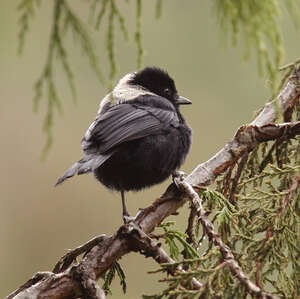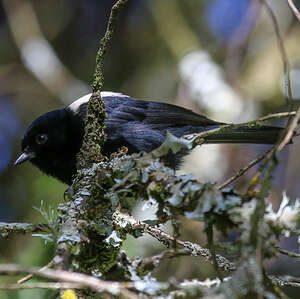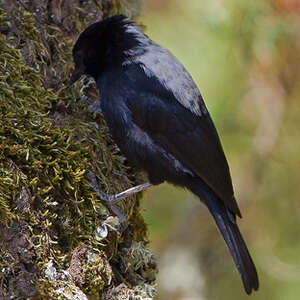White-backed Black Tit
Melaniparus leuconotus - Mésange à dos blanc
Identification
The White-backed Black Tit is a little known species. Although quite common in its habitat, it has not been the subject of extensive study. When it entered The Bird of the World in 2020, no nesting sites had been studied and documented yet. This small tit is easily identifiable, being a glossy black in good light and, as its name suggests, with a white back more specifically the mantle since the back itself is black. The lower neck has an angular spot of the same color. There is no sexual dimorphism. In some individuals, the under-tail coverts and some upper wing coverts are white. Secondary and tertiary remiges have white fringes. The tail is black with the outer rectrices bordered and white-tipped. The iris is brown, the bill is black and shiny, the legs are grey to dark grey. The juvenile is duller, more brown-black than deep black.
Subspecific information monotypic species
Foreign names
- Mésange à dos blanc,
- Carbonero dorsiblanco,
- chapim-de-dorso-branco,
- Weißmantel-Rußmeise,
- fehérhátú cinege,
- Witrugmees,
- Cincia dorsobianco,
- vitryggig mes,
- Hvitryggmeis,
- sýkorka bielochrbtá,
- sýkora etiopská,
- Etiopisk Mejse,
- etiopiantiainen,
- mallerenga negra de dors blanc,
- sikora jasnogrzbieta,
- Белоспинная синица,
- セジロクロガラ,
- 白背黑山雀,
- vitryggig mes,
- 白背山雀,
Voice song and call
The White-backed Black Tit is a vocal species with a varied repertoire of both soft and loud cries. Rarely among tits, the species has a song which is a fairly melodic babbling of full and liquid notes similar to a bulbul. It is common for couples to sing together for a long time. Cries are diverse and can evoke those of more well-known species. Thus they will make tsi si si si si... sounds of a Blue Tit, and a sé dé dé dé dé ending that reminds of a Marsh Tit. There are also psi dut...psi du dut from a Great Tit, as well as isolated or intercalated notes of a sparrow. Certain sounds resemble those of other tits with which this species seems to have genetic affinities, such as the Southern Black Tit, Western Black Tit, and Grey-headed Black Tit, two species of southern Africa. The juvenile is also quite loud, emitting high-pitched cries when begging for food.
Habitat
The White-backed Black Tit resides permanently in the high mountain ranges of the Ethiopian Highlands and mainly in thicket and woodland habitats between 1,800 and 3,500 metres altitude in Ethiopia, and between 2,000 and 2,600 metres in Eritrea.
Behaviour character trait
The White-backed Black Tit is not unnoticeable for those who are familiar with its vocalisations. It is a sociable bird.
It moves in couples or small, active groups. The lack of other species of tits in a large part of its range would explain the lack of typical flocks for the family. As acrobatic as our Blue Tit, it actively searches for its food on tree trunks, sometimes hanging by its feet from branches and twigs, where it unearths the invertebrates hidden beneath the lichens and mosses as well as in bushes and shrubs. For breeding, territoriality would be weak and couples would tolerate or even seek proximity to other couples.Flight
Dietfeeding habits
Reproduction nesting
Observations of youngsters show that breeding of the White-backed Black Tit appears to take place all year round in Ethiopia. In Eritrea, it would coincide with the rainy season. However, one can only assume that it nests in a cavity, as is the case with Parids, as no data is available in this regard. The details of the breeding are still to be documented today.
Threats - protection
IUCN conservation status
concern
in the Wild
threatened
evaluated
The population of White-backed Black Tit present in the highland tropical forests of Ethiopia appears to be stable and the species remains common to fairly common. Individuals were rediscovered in Eritrea since 2008 after 50 years of data absence probably due more to the conflicts of the region than to an absence of the species. The recent deforestation in Eritrea certainly has a negative impact on the population of tits. In 2016, it was classified as "of minor concern" by Birdlife International.
Sources of information
- IOC World Bird List (v15.1), Gill, F and D Donsker (Eds). 2025-12-07.
- Birds of the World, The Cornell Lab of Ornithology
- Birds of the Horn of Africa, Nigel Redman
- xeno-canto, Sharing bird sounds from around the world,
Other sources of interest
 Specification sheet created on
18/07/2023 by Nathalie Santa Maria
Specification sheet created on
18/07/2023 by Nathalie Santa MariaTranslation by AI Oiseaux.net
© 1996-2025 Oiseaux.net
- Accipitriformes
- Aegotheliformes
- Anseriformes
- Apodiformes
- Apterygiformes
- Bucerotiformes
- Caprimulgiformes
- Cariamiformes
- Casuariiformes
- Charadriiformes
- Ciconiiformes
- Coliiformes
- Columbiformes
- Coraciiformes
- Cuculiformes
- Eurypygiformes
- Falconiformes
- Galliformes
- Gaviiformes
- Gruiformes
- Leptosomiformes
- Mesitornithiformes
- Musophagiformes
- Nyctibiiformes
- Opisthocomiformes
- Otidiformes
- Passeriformes
- Pelecaniformes
- Phaethontiformes
- Phoenicopteriformes
- Piciformes
- Podargiformes
- Podicipediformes
- Procellariiformes
- Psittaciformes
- Pterocliformes
- Rheiformes
- Sphenisciformes
- Steatornithiformes
- Strigiformes
- Struthioniformes
- Suliformes
- Tinamiformes
- Trogoniformes





















